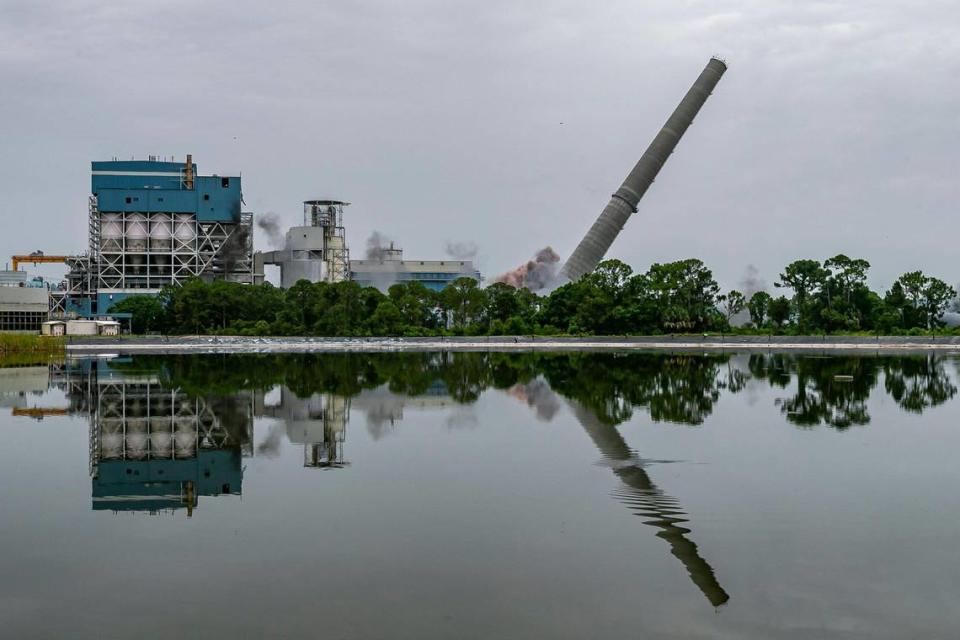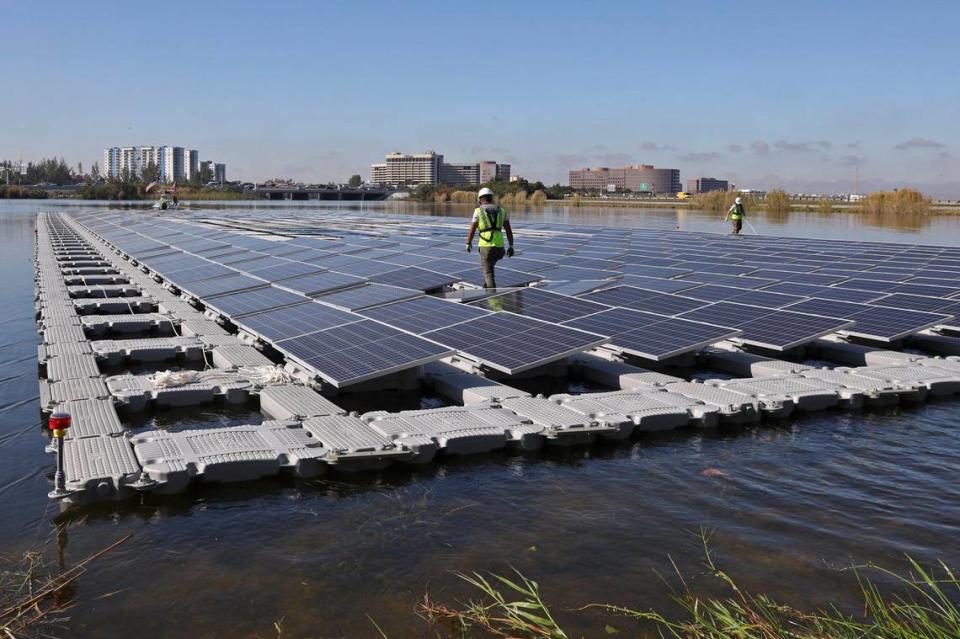FPL is done with coal in Florida. But can it get to 100% clean energy by 2035?
Florida Power & Light’s last coal plant in the state collapsed with a flash of explosives and a boom so loud it rippled the polyester roof of the spectators’ tent, where local business owners, government officials and utility employees cheered.
“It’s a really good example of how you take [out] the old and you bring in the new,” CEO Eric Silagy told the crowd, his words nearly drowned out by a safety buzzer heralding the demolition of the stack and coal chute of the Indiantown Cogeneration plant in Martin County.
The “new”, he announced moments before the explosion, will be a 500-acre solar generation plant built near the Indiantown site sometime in the future.
It was a triumphant moment for Florida’s largest utility, which clearly sees itself as headed in the right direction for weaning itself off the fossil fuels that cause climate change, a threat that is projected to eat up thousands of acres of Florida coastline and cost billions to keep at bay by mid-century.
“We’ve advanced our knowledge of what the impacts are, both environmentally and economically, and we have come to the conclusion that we can do this better,” Silagy told the crowd. “This is not easy to do, but it’s doable.”
Carbon emissions from burning fossil fuel for energy are the number one contributor to global warming, and utilities around the world are under pressure to switch to renewable energy like solar, wind and nuclear — quickly. President Joe Biden signed an executive order declaring that America would produce 100% carbon-free electricity by 2035, an important milestone to meet if the world hopes to limit global warming.
Cities across Florida have also committed to curbing their emissions drastically by that time, including Miami and St. Petersburg, while others, including Orlando, plan to take until 2050 to do so.
On Earth Day, a flurry of plans to slash carbon emissions in Miami-Dade and Miami
While there’s plenty those cities can do to lower their footprint (like electrifying the city fleet and encouraging people to use public transit) the bulk of that transformation lies with FPL, which holds a monopoly over most of the state.
But according to FPL’s latest projections, it only expects to produce 40% of its energy from renewable sources by 2029.
When asked how the company would bridge that gap to 100%, Silagy praised the president for “setting high goals,” and said he agreed that the goal should be “a zero-emissions economy, over time”.
“You have to do it so you can reliably keep the power on and people can afford it, and that’s what our goal is,” he said.
FPL is in the midst of asking the state for permission to charge ratepayers an additional $2 billion dollars over the next four years to expand its natural gas infrastructure, build more clean energy and increase its profit margins.
If enacted, the plan would hike the bill for a home that uses 1,000 kilowatt-hours a month by about 18% between 2022 and 2025.

No more coal or oil
FPL says it needs that cash infusion to continue on its path to decarbonization, but critics argue the utility isn’t moving fast enough.
So far, FPL has pretty much weaned itself off the two dirtiest fuel sources: coal and oil.
The Indiantown plant stopped producing energy in December, leaving only two more coal plants in FPL’s portfolio, both newly added through a merger with Gulf Power — one in Georgia and one in Mississippi. FPL said it expects to cease its ownership of these plants in 2022 and 2024, respectively.
FPL has also massively reduced its dependence on oil. Twenty years ago, the utility burned 40 million barrels of oil a year, more than any other utility. They’ve reduced that 99%. The remaining 1%, Silagy said, the utility is required to burn to prove it can use diesel as a backup fuel in case of an emergency.
“By the way, nobody asked us to do that. Nobody ordered us to do that. There was no state mandate, there was no federal mandate. We did it on our own,” he said.
Both coal and oil because increasingly unpopular — and unprofitable — as energy sources over the last few decades, according to the Energy Information Institute.
Now the bulk of FPL’s energy is produced from burning natural gas, a fossil fuel mainly made of methane, a greenhouse gas that warms the atmosphere much more than carbon dioxide. FPL is opening a new natural gas plant in Dania Beach next year that’s expected to run for at least 30 years.
It also has permission from the state to build two more in the coming decade, but FPL Spokesman Bill Orlove said the Dania Beach plant will be the last in FPL’s service area.
“We don’t think we’re building another one,” he said.
If the utility’s request for $2 billion is approved, a big chunk of that cash would go toward expanding the natural-gas burning capacity at several plants, something environmental advocates call bad investments.
Bradley Marshall, a senior attorney for environmental advocacy group Earthjustice, said the natural gas expansions a step backward in the fight against climate change.
“In order to make progress toward a renewable energy future, we don’t want to see bills go up for fossil fuel investments we don’t need,” he said.
Can it be done?
FPL has released no plans for reducing its carbon emissions to zero, unlike other peer utilities.
Its only public goal is that it plans to shrink its carbon emissions rate (not its overall emissions) 67% by 2025. That means FPL could make each power plant more efficient but build a lot more of them and still meet its goal, despite raising its total amount of emissions.
The South Alliance for Clean Energy analyzed the clean energy strategies of various utilities in the southeast and found that, at its current pace, FPL would likely reach carbon neutrality by 2071.
Maggie Shober, the director of utility reform at the Southern Alliance for Clean Energy, and her team outlined two strategies for FPL to meet that goal as soon as 2035. Both involve more wind power, something no utility in Florida has invested in due to unfavorable conditions in much of the state, and a lot more solar power.
FPL has already built 41 solar power plants as part of its 30-by-30 plan to build 30 million solar panels by 2030. Almost every plant, including the planned Indiantown one, produces 74.5 MW of energy, which is just under the 75 MW threshold where FPL would have to do an assessment of the power needs of the community and put the project out to bid with third-party contractors.

It’s also building the world’s largest solar-powered battery storage facility in Manatee County. Battery storage allows utilities to store the excess solar energy earned during the day to use at night or on cloudy days, and experts consider it a critical technology for shifting away from fossil fuels.
Shober’s strategy would call for at least half of FPL’s energy to come from solar, as opposed to the 16% FPL is planning by 2029, as well as an expansion of rooftop solar on homes and businesses, something FPL has historically opposed.
“The way that the system is set up is utilities are encouraged to build things. That’s how they earn the rate of return for their shareholders. Whether it makes sense to build that gas plant for their customers or not, the incentive is there to build it,” she said.
When it comes to rooftop solar and energy efficiency (both key to meeting carbon neutrality goals), Shober said “the incentives just aren’t there for FPL to invest in these as much.”

Other energy researchers, like Ben Haley with Evolved Energy Research, see existing natural gas plants as part of the solution. They’re a cheaper backup than battery storage, he said, and it could potentially be retrofitted to run on zero-carbon fuel in the future.
FPL is betting on the alternate fuel scenario with its new “green hydrogen” pilot project, which would be funded by the rate increase. The proposed plant would use solar to turn water into hydrogen, which can fuel some machines. The Biden administration’s infrastructure plan also calls for several hydrogen pilot projects across the county.
“They can basically be useful and used in a very limited fashion in the long run,” Haley said. “It allows utilities to whistle past the graveyard of the reality of decarbonization.”
Haley’s firm’s also ran models on how Florida utilities could get to zero carbon by 2035. They also found it was possible, as long as utilities invested heavily in solar and stopped building coal or natural gas plants now.
“Starting now is the only rational strategy with the scale of where we need to go in the next 30 years,” he said. “It may be a real missed opportunity if FPL is behind that curve.”

